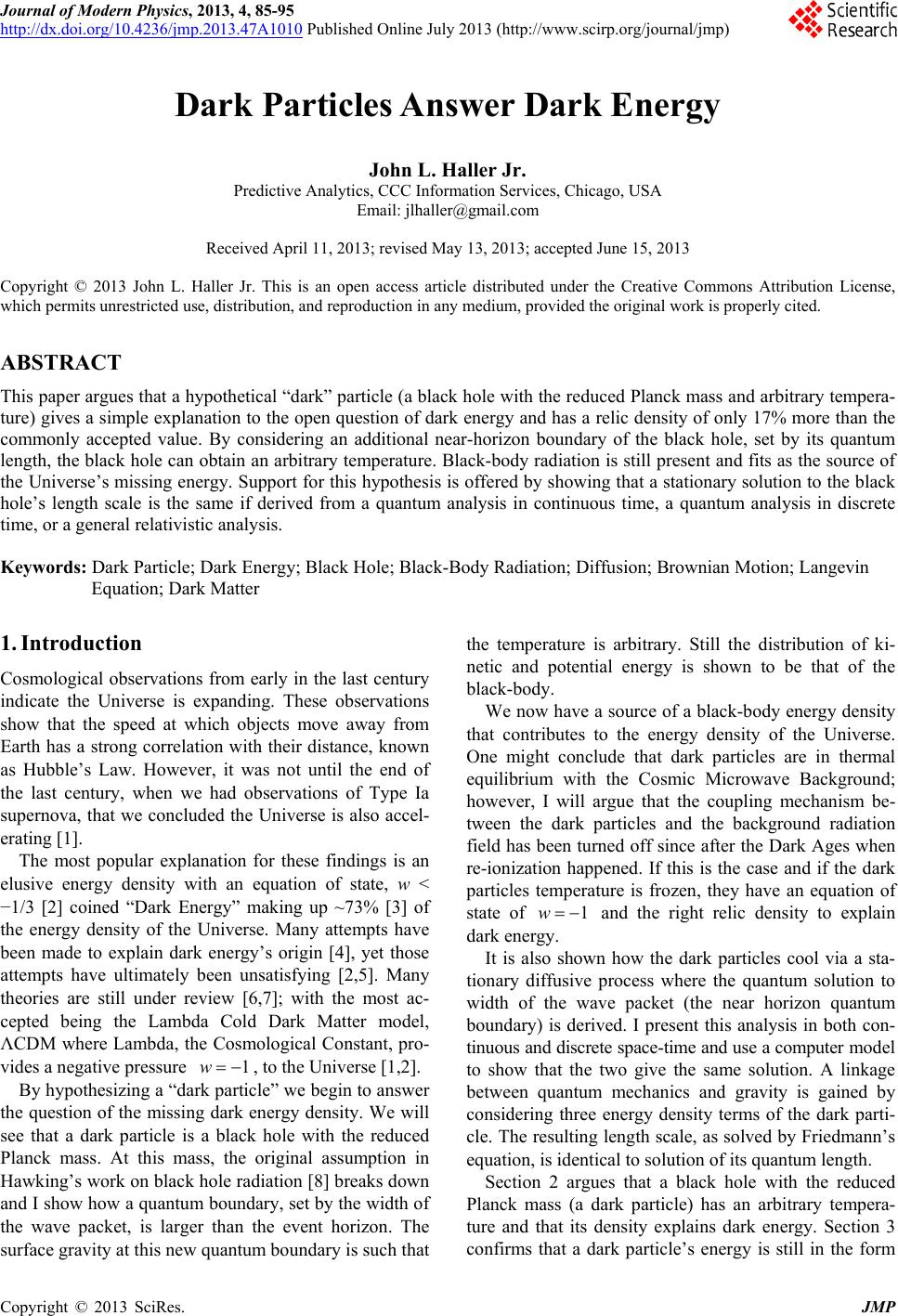 Journal of Modern Physics, 2013, 4, 85-95 http://dx.doi.org/10.4236/jmp.2013.47A1010 Published Online July 2013 (http://www.scirp.org/journal/jmp) Dark Particles Answer Dark Energy John L. Haller Jr. Predictive Analytics, CCC Information Services, Chicago, USA Email: jlhaller@gmail.com Received April 11, 2013; revised May 13, 2013; accepted June 15, 2013 Copyright © 2013 John L. Haller Jr. This is an open access article distributed under the Creative Commons Attribution License, which permits unrestricted use, distribution, and reproduction in any medium, provided the original work is properly cited. ABSTRACT This paper argues that a hypothetical “dark” particle (a black hole with the reduced Planck mass and arbitrary tempera- ture) gives a simple explanation to the open question of dark energy and has a relic density of only 17% more than the commonly accepted value. By considering an additional near-horizon boundary of the black hole, set by its quantum length, the black hole can obtain an arbitrary temperature. Black-body radiation is still present and fits as the source of the Universe’s missing energy. Support for this hypothesis is offered by showing that a stationary solution to the black hole’s length scale is the same if derived from a quantum analysis in continuous time, a quantum analysis in discrete time, or a general relativistic analysis. Keywords: Dark Particle; Dark Energy; Black Hole; Black-Body Radiation; Diffusion; Brownian Motion; Langevin Equation; Dark Matter 1. Introduction Cosmological observations from early in the last century indicate the Universe is expanding. These observations show that the speed at which objects move away from Earth has a strong correlation with their distance, known as Hubble’s Law. However, it was not until the end of the last century, when we had observations of Type Ia supernova, that we concluded the Universe is also accel- erating [1]. The most popular explanation for these findings is an elusive energy density with an equation of state, w < −1/3 [2] coined “Dark Energy” making up ~73% [3] of the energy density of the Universe. Many attempts have been made to explain dark energy’s origin [4], yet those attempts have ultimately been unsatisfying [2,5]. Many theories are still under review [6,7]; with the most ac- cepted being the Lambda Cold Dark Matter model, ΛCDM where Lambda, the Cosmological Constant, pro- vides a negative pressure , to the Universe [1,2]. 1w 1w By hypothesizing a “dark particle” we begin to answer the question of the missing dark energy density. We will see that a dark particle is a black hole with the reduced Planck mass. At this mass, the original assumption in Hawking’s work on black hole radiation [8] breaks down and I show how a quantum boundary, set by the width of the wave packet, is larger than the event horizon. The surface gravity at this new quantum boundary is such that the temperature is arbitrary. Still the distribution of ki- netic and potential energy is shown to be that of the black-body. We now have a source of a black-body energy density that contributes to the energy density of the Universe. One might conclude that dark particles are in thermal equilibrium with the Cosmic Microwave Background; however, I will argue that the coupling mechanism be- tween the dark particles and the background radiation field has been turned off since after the Dark Ages when re-ionization happened. If this is the case and if the dark particles temperature is frozen, they have an equation of state of and the right relic density to explain dark energy. It is also shown how the dark particles cool via a sta- tionary diffusive process where the quantum solution to width of the wave packet (the near horizon quantum boundary) is derived. I present this analysis in both con- tinuous and discrete space-time and use a computer model to show that the two give the same solution. A linkage between quantum mechanics and gravity is gained by considering three energy density terms of the dark parti- cle. The resulting length scale, as solved by Friedmann’s equation, is identical to solution of its quantum length. Section 2 argues that a black hole with the reduced Planck mass (a dark particle) has an arbitrary tempera- ture and that its density explains dark energy. Section 3 confirms that a dark particle’s energy is still in the form C opyright © 2013 SciRes. JMP 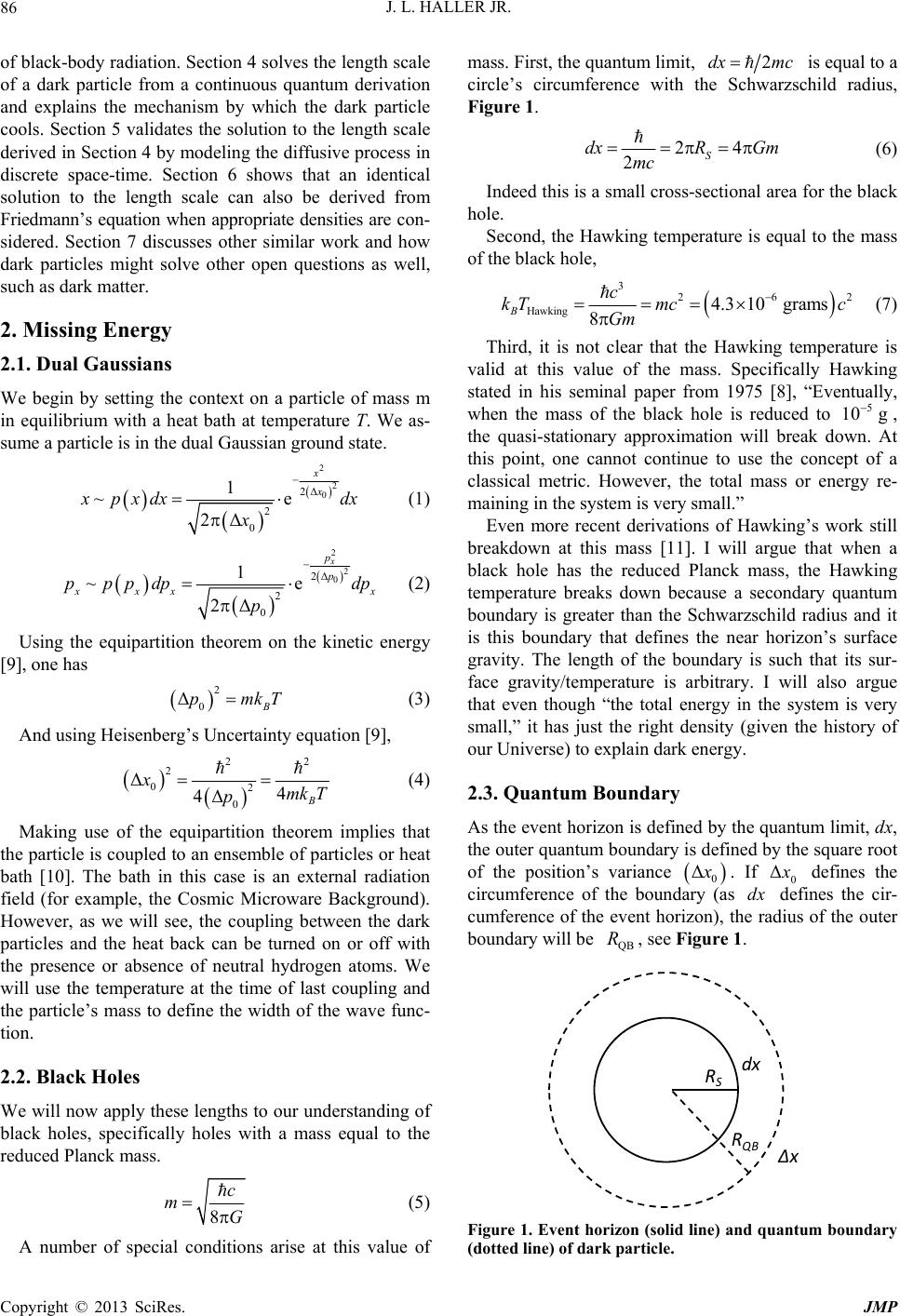 J. L. HALLER JR. 86 of black-body radiation. Section 4 solves the length scale of a dark particle from a continuous quantum derivation and explains the mechanism by which the dark particle cools. Section 5 validates the solution to the length scale derived in Section 4 by modeling the diffusive process in discrete space-time. Section 6 shows that an identical solution to the length scale can also be derived from Friedmann’s equation when appropriate densities are con- sidered. Section 7 discusses other similar work and how dark particles might solve other open questions as well, such as dark matter. 2. Missing Energy 2.1. Dual Gaussians We begin by setting the context on a particle of mass m in equilibrium with a heat bath at temperature T. We as- sume a particle is in the dual Gaussian ground state. 2 2 0 2Δ 2e x x 0 1 ~ 2Δ px dxx dx (1) 2 2 0 2Δ e x p p 2 0 1 ~ 2Δ xx pppdp p x dp 2 0B (2) Using the equipartition theorem on the kinetic energy [9], one has Δ mk T (3) And using Heisenberg’s Uncertainty equation [9], 22 2 04B mk T 2 0 Δ 4Δ xp (4) Making use of the equipartition theorem implies that the particle is coupled to an ensemble of particles or heat bath [10]. The bath in this case is an external radiation field (for example, the Cosmic Microware Background). However, as we will see, the coupling between the dark particles and the heat back can be turned on or off with the presence or absence of neutral hydrogen atoms. We will use the temperature at the time of last coupling and the particle’s mass to define the width of the wave func- tion. 2.2. Black Holes We will now apply these lengths to our understanding of black holes, specifically holes with a mass equal to the reduced Planck mass. 8 c mG (5) A number of special conditions arise at this value of mass. First, the quantum limit, 2dx mc is equal to a circle’s circumference with the Schwarzschild radius, Figure 1. 24 2S dxR Gm mc (6) Indeed this is a small cross-sectional area for the black hole. Second, the Hawking temperature is equal to the mass of the black hole, 3 262 Hawking 4.3 10grams 8 Bc kT mcc Gm 5 10 g (7) Third, it is not clear that the Hawking temperature is valid at this value of the mass. Specifically Hawking stated in his seminal paper from 1975 [8], “Eventually, when the mass of the black hole is reduced to , the quasi-stationary approximation will break down. At this point, one cannot continue to use the concept of a classical metric. However, the total mass or energy re- maining in the system is very small.” Even more recent derivations of Hawking’s work still breakdown at this mass [11]. I will argue that when a black hole has the reduced Planck mass, the Hawking temperature breaks down because a secondary quantum boundary is greater than the Schwarzschild radius and it is this boundary that defines the near horizon’s surface gravity. The length of the boundary is such that its sur- face gravity/temperature is arbitrary. I will also argue that even though “the total energy in the system is very small,” it has just the right density (given the history of our Universe) to explain dark energy. 2.3. Quantum Boundary As the event horizon is defined by the quantum limit, dx, the outer quantum boundary is defined by the square root of the position’s variance 0 Δ . If 0 Δ defines the circumference of the boundary (as defines the cir- cumference of the event horizon), the radius of the outer boundary will be , see Figure 1. dx QB R RS dx RQB Δx Figure 1. Event horizon (solid line) and quantum boundary (dotted line) of dark particle. Copyright © 2013 SciRes. JMP  J. L. HALLER JR. 87 Nocoupling mechanism 0 QB Δ 2π x R4πB mk T r (8) The surface gravity at radius is [12], 222 Gm Gm cr cr QB R 12 1 2 rr (9) The effective temperature [8] for surface gravity at ra- dius will thus be, 2 8πGm T TT c R QB DarkParticle 2πB R kc (10) The width of the black hole’s wave packet (which is set by the temperature of the heat bath) that defines the outer quantum boundary is just the right size to define a surface gravity such that the temperature is arbitrary and not a function of mass or other defining feature of the black hole. The temperature is its own independent pa- rameter of the black hole. Thus I will call a black hole with the reduced Planck mass and arbitrary temperature a dark particle. ω 2 Couplingmechanism thro u gh hydrogenatoms Hydrogenatoms ω 1 When the mass of a black hole is greater than the re- duced Planck mass, the quantum boundary QB is nec- essarily smaller than RSchwarzschild and thus it is RSchwarzschild that defines the surface gravity. When the black hole is a dark particle it can’t lose any more mass lest its quantum limit will become larger than RSchwarzschild; thus it will cease to be a black hole. If the dark particle loses radia- tion it must shed its non-massive energy and thus de- crease in temperature. On the flip side, if the dark parti- cle is in a heat bath at a higher temperature than the dark particle, it will match that larger temperature (assuming a coupling mechanism is in place) without gaining mass until the reduced Planck temperature is reached. 2.4. Dark Energy Now hypothesize that a local group of dark particles are able to exchange heat with the Cosmic Microwave Back- ground wh en neutral hydrogen atoms or other sinks are nearby to capture the radiation from its gravitational binding but that th ey become frozen (constant tempera- ture) when neutral hydrogen atoms are not nearby. This hypothesis rests on the idea that a virtual particle that leaves its pair becomes trapped by the outer quantum boundary, even if it escapes the event horizon, unless a sink is around to capture it. See Figure 2. With no sink the net energy to escape is zero. However if a sink is around, like a neutral hydrogen atom, the sink can absorb radiation at one energy and release radiation into the dark particle at another energy, keeping it in thermal equilib- rium. During the dark ages, the time between decoupling and re-ionization [13], the Universe was filled with hydrogen Figure 2. Without a coupling mechanism, the radiation can’t escape thereby not allowing the dark particle to cool. However with a hydrogen atom or other sink the dark par- ticle can equilibrate with the background field. atoms that provided the coupling mechanism between the dark particles and regular energy. In these conditions the dark particles were coupled to the Cosmic Microwave Background (CMB). However after re-ionization, the hydrogen was ionized and the dark particles and its asso- ciated radiation energy density became frozen. The red-shift of re-ionization and the current temperature of the CMB provide an estimate of the temperature of the dark particles at the time of re-ionization where it re- mains constant up to today. DPRe-ionization CMB-today 1 constantTz T (11) If we know the temperature of the dark particles at re-ionization, then we should have an idea for the total energy density that contributes to the Cosmological con- stant today. 4 2 Dark Particles-BBR35 15 BDP kT c D (12) Because we have estimates of today’s z value of re- ionization and today’s temperature of the CMB we can estimate the density, P-BBR . The Lambda Cold Dark Matter model, , provides a completely inde- pendent estimate of the density of dark energy, Λ ΛCDM CDM [1], which we can estimate using the parameter, , and today’s Hubble constant. Λ Ω 2 ΛΛcritical Λ 3 ΩΩ 8 CDM G (13) Copyright © 2013 SciRes. JMP 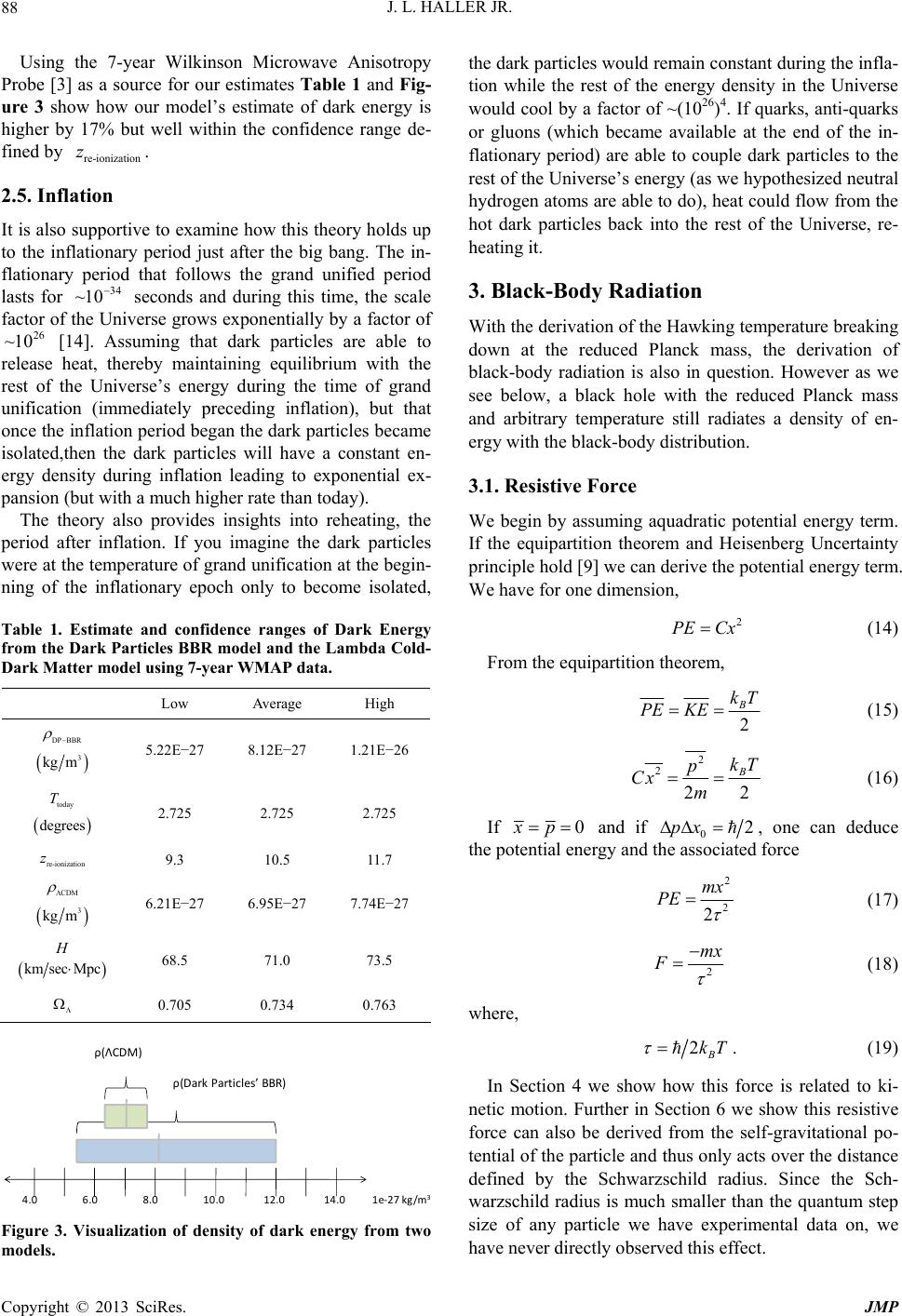 J. L. HALLER JR. 88 Using the 7-year Wilkinson Microwave Anisotropy Probe [3] as a source for our estimates Table 1 and Fig- ure 3 show how our model’s estimate of dark energy is higher by 17% but well within the confidence range de- fined by . re-ionization z 34 ~10 26 0 2.5. Inflation It is also supportive to examine how this theory holds up to the inflationary period just after the big bang. The in- flationary period that follows the grand unified period lasts for seconds and during this time, the scale factor of the Universe grows exponentially by a factor of [14]. Assuming that dark particles are able to release heat, thereby maintaining equilibrium with the rest of the Universe’s energy during the time of grand unification (immediately preceding inflation), but that once the inflation period began the dark particles became isolated,then the dark particles will have a constant en- ergy density during inflation leading to exponential ex- pansion (but with a much higher rate than today). ~1 The theory also provides insights into reheating, the period after inflation. If you imagine the dark particles were at the temperature of grand unification at the begin- ning of the inflationary epoch only to become isolated, Table 1. Estimate and confidence ranges of Dark Energy from the Dark Particles BBR model and the Lambda Cold- Dark Matter model using 7-year WMAP data. Low Average High DP BBR 3 kg m 5.22E−27 8.12E−27 1.21E−26 today T degrees re-ionization z CDM 2.725 2.725 2.725 9.3 10.5 11.7 3 kg m H 6.21E−27 6.95E−27 7.74E−27 km sec Mpc 68.5 71.0 73.5 0.705 0.734 0.763 4.0 6.0 8.0 10.012.014.01e‐27kg/m ρ(Dark Particles’BBR) ρ(ΛCDM) 2 PE Cx 3 Figure 3. Visualization of density of dark energy from two models. the dark particles would remain constant during the infla- tion while the rest of the energy density in the Universe would cool by a factor of ~(1026)4. If quarks, anti-quarks or gluons (which became available at the end of the in- flationary period) are able to couple dark particles to the rest of the Universe’s energy (as we hypothesized neutral hydrogen atoms are able to do), heat could flow from the hot dark particles back into the rest of the Universe, re- heating it. 3. Black-Body Radiation With the derivation of the Hawking temperature breaking down at the reduced Planck mass, the derivation of black-body radiation is also in question. However as we see below, a black hole with the reduced Planck mass and arbitrary temperature still radiates a density of en- ergy with the black-body distribution. 3.1. Resistive Force We begin by assuming aquadratic potential energy term. If the equipartition theorem and Heisenberg Uncertainty principle hold [9] we can derive the potential energy term. We have for one dimension, (14) From the equipartition theorem, 2 B kT PE KE (15) 2 2 22 B kT p Cx m (16) If 0xp and if 02px , one can deduce the potential energy and the associated force 2 2 2 mx PE (17) 2 mx F (18) where, 2B kT. (19) In Section 4 we show how this force is related to ki- netic motion. Further in Section 6 we show this resistive force can also be derived from the self-gravitational po- tential of the particle and thus only acts over the distance defined by the Schwarzschild radius. Since the Sch- warzschild radius is much smaller than the quantum step size of any particle we have experimental data on, we have never directly observed this effect. Copyright © 2013 SciRes. JMP 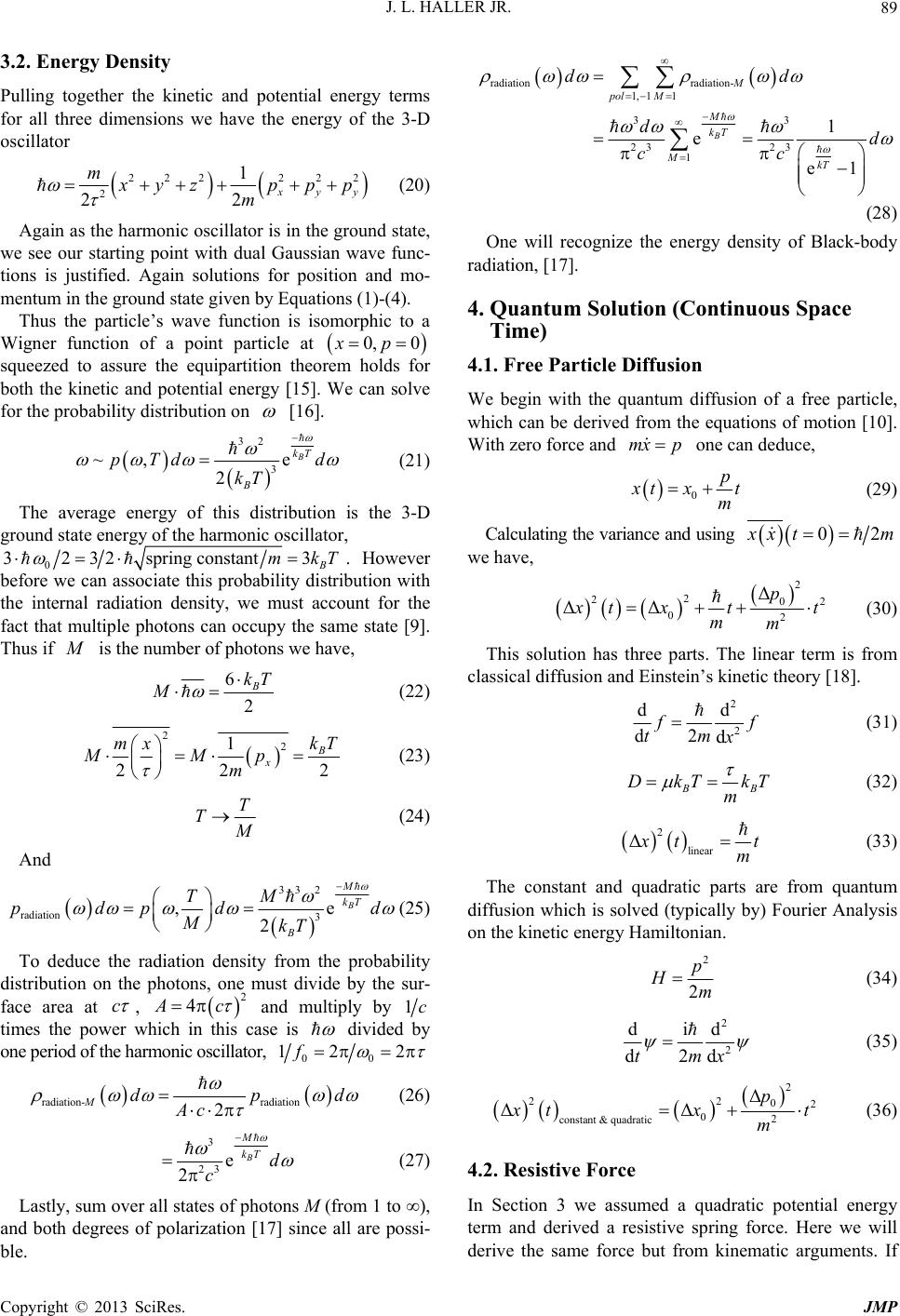 J. L. HALLER JR. 89 3.2. Energy Density Pulling together the kinetic and potential energy terms for all three dimensions we have the energy of the 3-D oscillator 2 2 2222 2 1 2 2 yy m yz m ppp 0, 0xp (20) Again as the harmonic oscillator is in the ground state, we see our starting point with dual Gaussian wave func- tions is justified. Again solutions for position and mo- mentum in the ground state given by Equations (1)-(4). Thus the particle’s wave function is isomorphic to a Wigner function of a point particle at squeezed to assure the equipartition theorem holds for both the kinetic and potential energy [15]. We can solve for the probability distribution on [16]. 32 3e B kT B d kT ~, 2 pTd (21) The average energy of this distribution is the 3-D ground state energy of the harmonic oscillator, 0 3232spring constant3mkT B. However before we can associate this probability distribution with the internal radiation density, we must account for the fact that multiple photons can occupy the same state [9]. Thus if is the number of photons we have, 6 2 B kT M (22) 21 22 mx MM m 2 2 B xkT p (23) T T (24) And 33 radiation , 2B TM pdpd MkT 2 3e B M kT d (25) To deduce the radiation density from the probability distribution on the photons, one must divide by the sur- face area at c , 2 4 c and multiply by 1 times the power which in this case is c divided by one period of the harmonic oscillator, 00 212f adiation pd radiation- r 2 Md Ac (26) 3 23 eB M kT d c 2 (27) radiation radiation- 1, 11 33 23 23 1 1 e e1 B M pol M M kT MkT dd dd cc mx p Lastly, sum over all states of photons M (from 1 to ∞), and both degrees of polarization [17] since all are possi- ble. (28) One will recognize the energy density of Black-body radiation, [17]. 4. Quantum Solution (Continuous Space Time) 4.1. Free Particle Diffusion We begin with the quantum diffusion of a free particle, which can be derived from the equations of motion [10]. With zero force and one can deduce, 0 p tx t m (29) Calculating the variance and using 02xt m we have, 2 2 202 02 Δ ΔΔ p tx tt mm (30) This solution has three parts. The linear term is from classical diffusion and Einstein’s kinetic theory [18]. 2 2 dd d2 d f tm x (31) BB kT kT m (32) 2 linear Δtt m (33) The constant and quadratic parts are from quantum diffusion which is solved (typically by) Fourier Analysis on the kinetic energy Hamiltonian. 2 2 p Hm (34) 2 2 did d2 d tm x (35) 2 2 202 02 constant & quadratic Δ ΔΔ p txt m (36) 4.2. Resistive Force In Section 3 we assumed a quadratic potential energy term and derived a resistive spring force. Here we will derive the same force but from kinematic arguments. If Copyright © 2013 SciRes. JMP 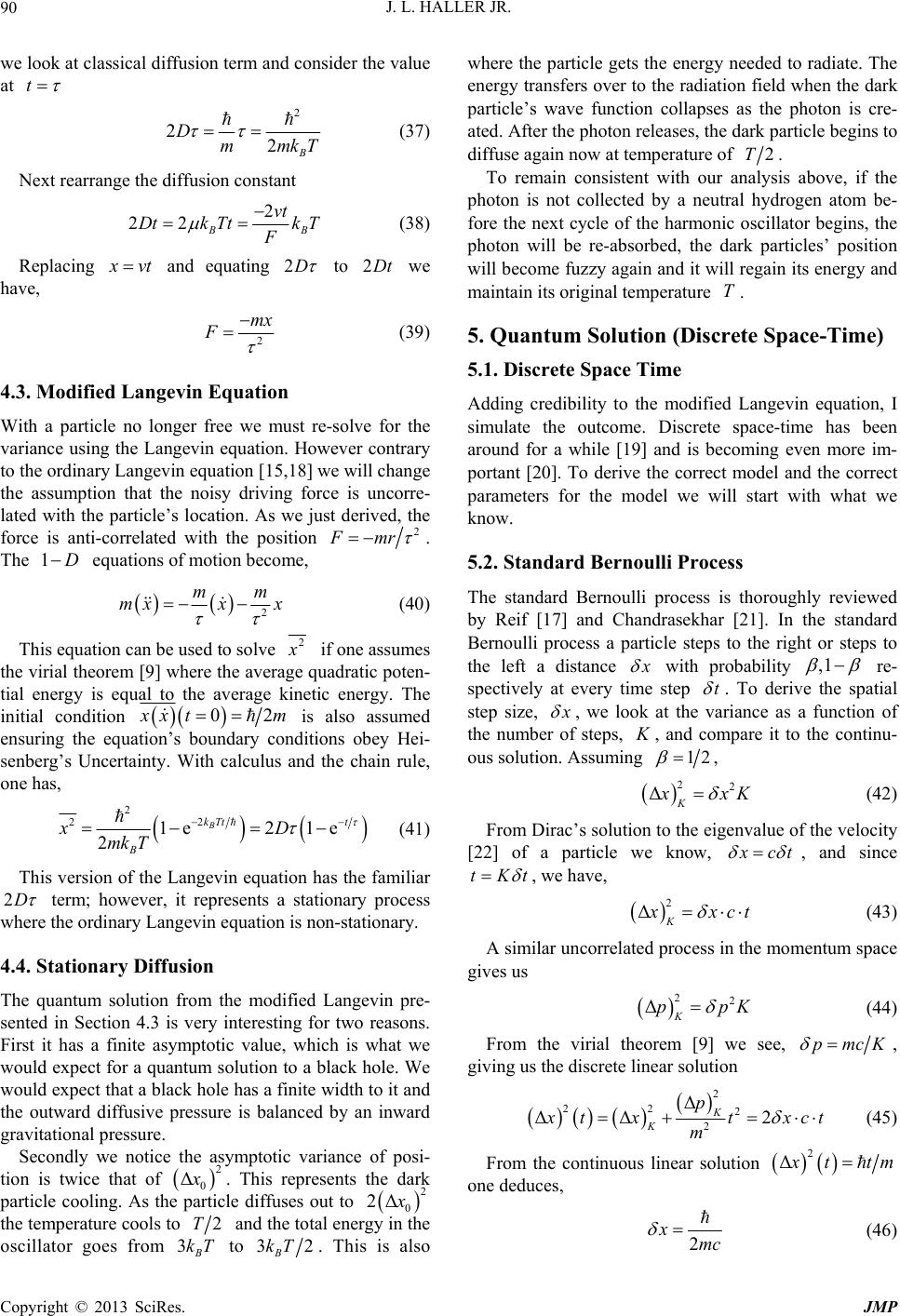 J. L. HALLER JR. 90 we look at classical diffusion term and consider the value at t 2 2B mm kT 2D (37) Next rearrange the diffusion constant 2 BB vt tk T22DtkT (38) Replacing vtD and equating 2 to we have, 2Dt 2 mx F (39) 4.3. Modified Langevin Equation With a particle no longer free we must re-solve for the variance using the Langevin equation. However contrary to the ordinary Langevin equation [15,18] we will change the assumption that the noisy driving force is uncorre- lated with the particle’s location. As we just derived, the force is anti-correlated with the position 2 Fmr 1D . The equations of motion become, 2 mm x x mx (40) This equation can be used to solve 2 if one assumes the virial theorem [9] where the average quadratic poten- tial energy is equal to the average kinetic energy. The initial condition 02 xt m is also assumed ensuring the equation’s boundary conditions obey Hei- senberg’s Uncertainty. With calculus and the chain rule, one has, 2 1e t D 2 2 21e 2 B kTt B x mk T 2D (41) This version of the Langevin equation has the familiar term; however, it represents a stationary process where the ordinary Langevin equation is non-stationary. 4.4. Stationary Diffusion The quantum solution from the modified Langevin pre- sented in Section 4.3 is very interesting for two reasons. First it has a finite asymptotic value, which is what we would expect for a quantum solution to a black hole. We would expect that a black hole has a finite width to it and the outward diffusive pressure is balanced by an inward gravitational pressure. Secondly we notice the asymptotic variance of posi- tion is twice that of 0 where the particle gets the energy needed to radiate. The energy transfers over to the radiation field when the dark particle’s wave function collapses as the photon is cre- ated. After the photon releases, the dark particle begins to diffuse again now at temperature of 2 Δ . This represents the dark particle cooling. As the particle diffuses out to 0 2 2Δ the temperature cools to 2T B kT and the total energy in the oscillator goes from 3 to 32 B kT . This is also 2T T . To remain consistent with our analysis above, if the photon is not collected by a neutral hydrogen atom be- fore the next cycle of the harmonic oscillator begins, the photon will be re-absorbed, the dark particles’ position will become fuzzy again and it will regain its energy and maintain its original temperature . 5. Quantum Solution (Discrete Space-Time) 5.1. Discrete Space Time Adding credibility to the modified Langevin equation, I simulate the outcome. Discrete space-time has been around for a while [19] and is becoming even more im- portant [20]. To derive the correct model and the correct parameters for the model we will start with what we know. 5.2. Standard Bernoulli Process The standard Bernoulli process is thoroughly reviewed by Reif [17] and Chandrasekhar [21]. In the standard Bernoulli process a particle steps to the right or steps to the left a distance ,1 with probability re- spectively at every time step t . To derive the spatial step size, , we look at the variance as a function of the number of steps, , and compare it to the continu- ous solution. Assuming 12, 22 ΔK xK (42) From Dirac’s solution to the eigenvalue of the velocity [22] of a particle we know, ct tKt , and since , we have, 2 ΔK xct 22 ΔK ppK (43) A similar uncorrelated process in the momentum space gives us (44) From the virial theorem [9] we see, pmcK , giving us the discrete linear solution 2 22 2 2 Δ ΔΔ 2 K K p txt xct m (45) 2 Δ From the continuous linear solution ttm one deduces, 2 xmc (46) Copyright © 2013 SciRes. JMP  J. L. HALLER JR. 91 5.3. Bernoulli Process with Resistive Force We can now proceed to modify the standard Bernoulli processes to account for the resistive force we found in the continuous case. We will find this discrete solution is equal to the modified continuous Langevin equation. To begin with, we need to match the continuous 1-D force, 2 Fmx with the ensemble average force experienced by the discrete case. The ensemble average force felt in the discrete case is the probability that the particle experiences a positive change in momentum times the impacted force pt plus the probability the particle experiences a negative change in momentum times pt . We can solve for the probability as a function of by examining the ensemble average discrete force on the particle felt at the location dur- ing time t . 1Fxxpp x tt (47) Solving for we have, 2 1mx t p 1 2 x p (48) We can reduce this further since we know and t . Since we are dealing with the harmonic oscillator the only energy transition can be in multiples of the quantized energy of the oscillator, 0B 2kT . Thus a change in momentum p must be equal to 2kTc tB; can also be replaced by 2 2mc as described above. 1 21B kT c x (49) The best way to show how this works is through a model where we show the variance of the position is equal to that of the modified continuous Langevin equa- tion. 5.4. Computer Model The following Matlab code shows the discrete model gives the same solution as the continuous modified Lange- vin. See Figures 4 and 5. G=6.67e-11; %Constants hbar=1.05e-34; c=3e8; m=sqrt(hbar*c/8/pi/G); %Mass dt=hbar/2/m/c^2; %Time step dx=c*dt; %Spatial step D=hbar/2/m; %Diffusion constant kT1=m*c^2/72; %Arbitrary Temperature #1 kT2=m*c^2/97; %Arbitrary Temperature #2 tau1=hbar/2/kT1; %Thermal time #1 tau2=hbar/2/kT2; %Thermal time #2 dp1=dx*m/tau1; %Momentum step #1 dp2=dx*m/tau2; %Momentum step #2 t=0:dt:2*pi*max(tau1,tau2); %Time vector N=100000; %Number of trials x1(:,1)=zeros(N,1); %Initial conditions x2(:,1)=zeros(N,1); p1(:,1)=zeros(N,1); p2(:,1)=zeros(N,1); for k=1:length(t)-1 %Determine probability Bx1=.5*(1-kT1*x1(:,k)/hbar/c); Bx2=.5*(1-kT2*x2(:,k)/hbar/c); Bp1=.5*(1-p1(:,k)*c*dt/hbar); Bp2=.5*(1-p2(:,k)*c*dt/hbar); %Sample the probability and step x1(:,k+1)=x1(:,k)+dx*(2*floor(rand(N,1)+Bx1)-1); x2(:,k+1)=x2(:,k)+dx*(2*floor(rand(N,1)+Bx2)-1); p1(:,k+1)=p1(:,k)+dp1*(2*floor(rand(N,1)+Bp1)-1); p2(:,k+1)=p2(:,k)+dp2*(2*floor(rand(N,1)+Bp2)-1); end %Update position to include momentum contribution x1=x1+p1*tau1/m; x2=x2+p2*tau2/m; figure(4) %Calculate variance from discrete model xvar1=mean(x1.*x1)-mean(x1).^2; xvar2=mean(x2.*x2)-mean(x2).^2; %Calculate variance from Langevin langevin1=2*D*tau1*(1-exp(-t/tau1)); langevin2=2*D*tau2*(1-exp(-t/tau2)); plot(t,xvar1) plot(t,langevin1,'r') plot(t,xvar2,'g') plot(t,langevin2,'k') figure(5) sigma=sqrt(2*D*tau1); %Asymptotic variance x=-4*sigma:dx/10:4*sigma; %Position vector P=hist(x1(:,length(t)),x)/N; %Calculate PMF %Calculate PDF p=1/sqrt(2*pi*sigma^2)*exp(-x.^2/2/(sigma^2))*dx; plot(x,P) plot(x,p,'r') Copyright © 2013 SciRes. JMP  J. L. HALLER JR. 92 Figure 4. The variance in position of a dark particle; com- parison between the discrete model and the exact continu- ous solution at two different temperatures. Figure 5. Probability distributions for one temperature; a comparison between discrete model and continuous theory. 6. Friedmann’s Equations Solutions We now show that by combining the energy density with three different equations of state, 1,13,&13w we arrive at the same solution as what was derived in both the continuous and discrete quantum solutions. The solutions to Friedmann’s equation with the densities standing alone correspond to the solutions to the linear and quadratic time terms of the variance when the parti- cle is free. We need to assume the particles comes as pairs such that we can define a general relativistic length scale and a quantum mechanical length scale . 6.1. Length Scales We define as twice the light time , the maximum distance two particles can traverse in time . 2 B c Lc kT (50) We define as the variance between the two parti- cles. If the two particles have independent wave func- tions we have 2Δ (51) Using these two definitions we will show that under three different equations of state (the solution to Friedmann’s equation) will be equal to (the variance of quantum diffusion). 6.2. Equation of State, w = 1/3 First for the equation of state 13w, we have the en- ergy in the 3-D oscillator 2222 2 2 2 1 2 2 yy m yz ppp m (52) We begin with the probability distribution on ~,pTd from Section 3.2 32 3 ~, e 2 B kT B pTd d kT 3kT 3 VL (53) Since we are no longer talking about photons/bosons like above but are talking about fermions we don’t have to account for multiple particles. The average energy of this distribution is the three dimensional ground state energy of the harmonic oscillator, . B If we consider a volume the energy density is 13 34 2 33 B wkT LcL cL (54) The Friedmann equation when the density is domi- nated by this equation of state, 13w becomes, 2 13 4 88 3w LGG L LcL (55) Solving for t we see it is equal to linear diffusive term from Section 4.1. 12 22 13 linear 32 2 wG Ltt cm (56) 6.3. Equation of State, w = −1/3 In deriving the density and solution for this equation of state we turn to a derivation of Friedmann’s equation [1]. We will start by deriving the gravitational explanation of the resistive spring force. Equating the average gravita- tional potential energy to 3 for 3 dimensions gives, 2 B kT gravity 3 2 B kT GMm PE r (57) Copyright © 2013 SciRes. JMP 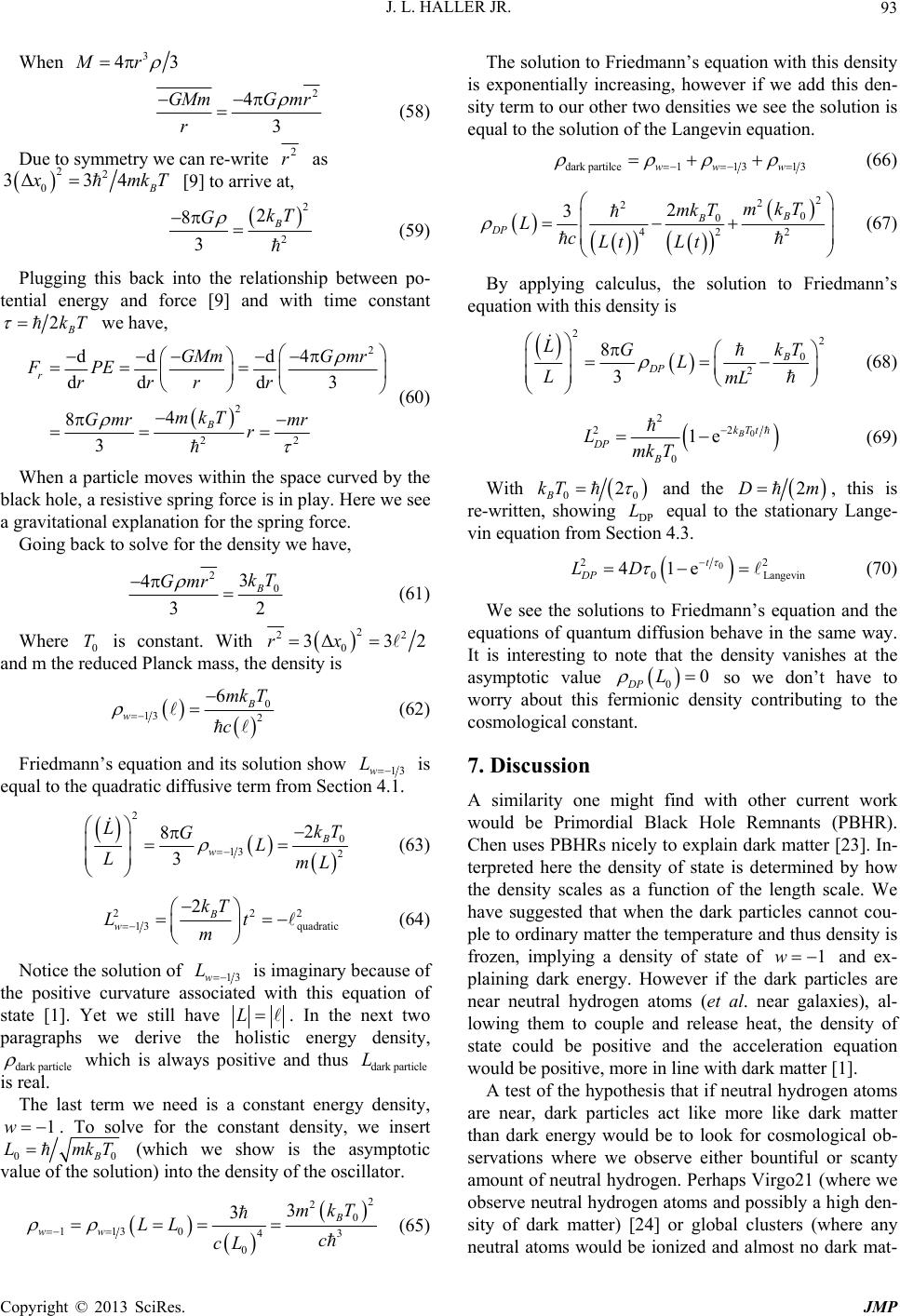 J. L. HALLER JR. 93 When 3 43Mr 2 4 3 GMmG mr r (58) Due to symmetry we can re-write 2 r as 2 0 3Δ2 34 B mk T [9] to arrive at, 2 2 2 8 3 B kT G (59) Plugging this back into the relationship between po- tential energy and force [9] and with time constant 2B kT we have, 2 2 22 dd d4 ddd 3 4 8 3 r B GMmGmr FPE rrrr mkT Gmr mr r (60) When a particle moves within the space curved by the black hole, a resistive spring force is in play. Here we see a gravitational explanation for the spring force. Going back to solve for the density we have, 2 0 3 32 B kT r T 4Gm (61) Where 0 is constant. With 2 22 3Δ32rx 0 and m the reduced Planck mass, the density is 0 2 6B mk T c 13w (62) Friedmann’s equation and its solution show 13 is equal to the quadratic diffusive term from Section 4.1. w L 2 13 8 3w LG L 0 2 2B kT LmL (63) 2 1 3 2B w kT L m 22 quadratic t (64) Notice the solution of 13w is imaginary because of the positive curvature associated with this equation of state [1]. Yet we still have L L cle . In the next two paragraphs we derive the holistic energy density, dark parti which is always positive and thus is real. dark particle L 1w The last term we need is a constant energy density, . To solve for the constant density, we insert 00B (which we show is the asymptotic value of the solution) into the density of the oscillator. LmkT 2 2 0 43 3B mkT c 11 3 0 0 3 ww LL cL (65) The solution to Friedmann’s equation with this density is exponentially increasing, however if we add this den- sity term to our other two densities we see the solution is equal to the solution of the Langevin equation. dark partilce11313ww w (66) 2 2 2 0 0 422 2 3B B DP mkT mk T LcLt Lt (67) By applying calculus, the solution to Friedmann’s equation with this density is 22 0 2 8 3 B DP LkT GL LmL (68) 0 2 2 2 0 1e B kTt DP B Lmk T (69) 0B0 2kT With and the 2m L, this is re-written, showing DP equal to the stationary Lange- vin equation from Section 4.3. 0 22 0 Langevin 41e t DP LD (70) We see the solutions to Friedmann’s equation and the equations of quantum diffusion behave in the same way. It is interesting to note that the density vanishes at the asymptotic value 0DP so we don’t have to worry about this fermionic density contributing to the cosmological constant. 0L 1w 7. Discussion A similarity one might find with other current work would be Primordial Black Hole Remnants (PBHR). Chen uses PBHRs nicely to explain dark matter [23]. In- terpreted here the density of state is determined by how the density scales as a function of the length scale. We have suggested that when the dark particles cannot cou- ple to ordinary matter the temperature and thus density is frozen, implying a density of state of and ex- plaining dark energy. However if the dark particles are near neutral hydrogen atoms (et al. near galaxies), al- lowing them to couple and release heat, the density of state could be positive and the acceleration equation would be positive, more in line with dark matter [1]. A test of the hypothesis that if neutral hydrogen atoms are near, dark particles act like more like dark matter than dark energy would be to look for cosmological ob- servations where we observe either bountiful or scanty amount of neutral hydrogen. Perhaps Virgo21 (where we observe neutral hydrogen atoms and possibly a high den- sity of dark matter) [24] or global clusters (where any neutral atoms would be ionized and almost no dark mat- Copyright © 2013 SciRes. JMP  J. L. HALLER JR. 94 ter) [25] could serve as a first validation. A further validation of this hypothesis might be ex- perimentally possible on Earth. A team led by Perl [26] has suggested two identical side-by-side atom interfer- ometers could reveal a dark energy density by measuring the time it takes for atoms to fall through gravity, respec- tively between the two interferometers. One could build on this approach and artificially alter the density of the dark particles by surrounding each interferometer in a bath of neutral hydrogen atoms (or other suitable sink that is not dangerous at high temperatures). One bath could be kept at a low temperature and the other at a high temperature. If the bath was large enough to allow the neutral hydrogen and the dark particles to couple and exchange heat before the dark energy reference frame moves past the interferometers [26], the density of dark particles that interacts with the falling atoms would be different between the hot and the cold interferometers and the difference would be measured. Questions still remain, like the exact mechanism for how the dark particle exchanges heat, and more analysis is needed for dark particles fully to answer the questions of dark energy [2,5], or for that matter other open ques- tions like dark matter [27]. Yet this initial brief report is intended to set the physical parameters and give guidance for how the forces of gravity and quantum mechanics work together and have complementary solutions in a simple straightforward way. While it is not possible to create a particle with the reduced Planck mass artificially, it would explain why prior experiments have been unable to locate the missing energy. As a note, the dark particle was built out of research in Finite Difference Time Domain (FDTD) modeling of diffusive motion [19]. By noticing a connection between Bernoulli’s process [17,21] and black-body radiation [17] it was possible to derive the continuous version of the theory. Application to Friedmann’s equation followed a need to explain the resistive spring force that keeps the particle stationary. When the theory suggested a density of black-body radiation was hidden (because the cross section of the dark particle is on the order of the Planck length) the tie to dark energy was made. Mountain View, CA, March 2011. 8. Acknowledgements JLH would like to thanks his family who encouraged him to stick with his work. JLH also would like to call out those around the world who helped, specifically in the Electrical Engineering and Physics departments at Prince- ton and Stanford where the foundation of this research was built. REFERENCES [1] A. Liddle, “An Introduction to Modern Cosmology,” 2nd Edition, John Wiley & Sons, Ltd., W. Sussex, 2003. [2] P. Peebles and B. Ratra, Reviews of Modern Physics, Vol. 75, 2003, pp. 559-606. doi:10.1103/RevModPhys.75.559 [3] D. Larson, J. Dunkley, et al., “Seven-Year Wilkinson Mi- crowave Anisotropy Probe (WMAP) Observations: Power Spectra and WMAP-Derived Parameters,” 2010. arXiv:1001.4635v2 [4] S. E. Rugh and H. Zinkernagel, Studies in History and Philosophy of Modern Physics, Vol. 33, 2002, pp. 663- 705. doi:10.1016/S1355-2198(02)00033-3 [5] B. Greene, “The Fabric of the Cosmos,” Vintage Books, New York, 2004. [6] L. Papantonopoulos, “Lecture Notes in Physics 720 The Invisible Universe: Dark Matter and Dark Energy,” Sprin- ger, Berlin, 2007. doi:10.1007/978-3-540-71013-4 [7] L. Amendola and S. Tsujikawa, “Dark Energy: Theory and Observations,” Cambridge University Press, Cam- bridge, 2010. doi:10.1017/CBO9780511750823 [8] S. W. Hawking, Communications in Mathematical Phys- ics, Vol. 43, 1975, pp. 199-220. doi:10.1007/BF02345020 [9] Feynman, “Lectures on Physics,” Addison-Wesley Pub- lishing, Reading, 1965. [10] C. W. Gardiner and P. Zoller, “Quantum Noise,” Springer, Berlin, 2004. [11] C. Barcelo, S. Liberati, S. Sonego and M. Visser, Physi- cal Review D, 83, 2011, Article ID: 041501. doi:10.1103/PhysRevD.83.041501 [12] S. A. Hayward, Classical and Quantum Gravity, Vol. 15, 1998, p. 3147. doi:10.1088/0264-9381/15/10/017 [13] R. Barkana and A. Loeb, Physics Reports, Vol. 349, 2001, pp. 125-238. doi:10.1016/S0370-1573(01)00019-9 [14] A. R. Liddle and D. H. Lyth, “Cosmological Inflation and Large-Scale Structure,” Cambridge University Press, Cam- bridge, 2000. doi:10.1017/CBO9781139175180 [15] D. F. Walls and G. J. Milburn, “Quantum Optics,” Springer, Berlin, 1994. [16] J. Pan, “Email Correspondence,” Fudan University, Shang- hai, 2007. [17] Reif, “Fundamentals of Statistical and Thermal Physics,” McGraw Hill, Boston, 1965. [18] R. Kubo, Reports on Progress in Physics, Vol. 29, 1966, p. 255. doi:10.1088/0034-4885/29/1/306 [19] Forsythe & Wasow, “Finite-Difference Methods for Par- tial Differential Equations,” John Wiley & Sons, Inc., New York, 1960. [20] M. Mecklenburg and B. C. Regan, Physical Review Let- ters, Vol. 106, 2011, Article ID: 116803. doi:10.1103/PhysRevLett.106.116803 [21] Chandrasakhar, Reviews of Modern Physics, Vol. 15, 1943. [22] P. A. M. Dirac, “The Principles of Quantum Mechanics,” 4th Edition, Oxford University Press, Oxford, 1958, p. 262. Copyright © 2013 SciRes. JMP  J. L. HALLER JR. Copyright © 2013 SciRes. JMP 95 [23] P. Chen, “Generalized Uncertainty Principle and Dark Matter,” Quantum Aspects of Beam Physics, World Sci- entific Publishing, Singapore, 2004, p. 315. [24] R. Minchin, et al., Astrophysics Journal, Vol. 670, 2007, pp. 1056-1064. doi:10.1086/520620 [25] S. Mashchenko and A. Sills, Astrophysical Journal, Vol. 619, 2005, pp. 243-257. doi:10.1086/426132 [26] R. J. Adler, H. Mueller and M. L. Perl, “A Terrestrial Search for Dark Contents of the Vacuum, Such as Dark Energy, Using Atom Interferometry,” 2011. arXiv:1101.5626v1 [27] Bertone & Silk, “Particle Dark Matter: Observations, Models, and Searches,” Cambridge University Press, Cam- bridge, 2010.
|